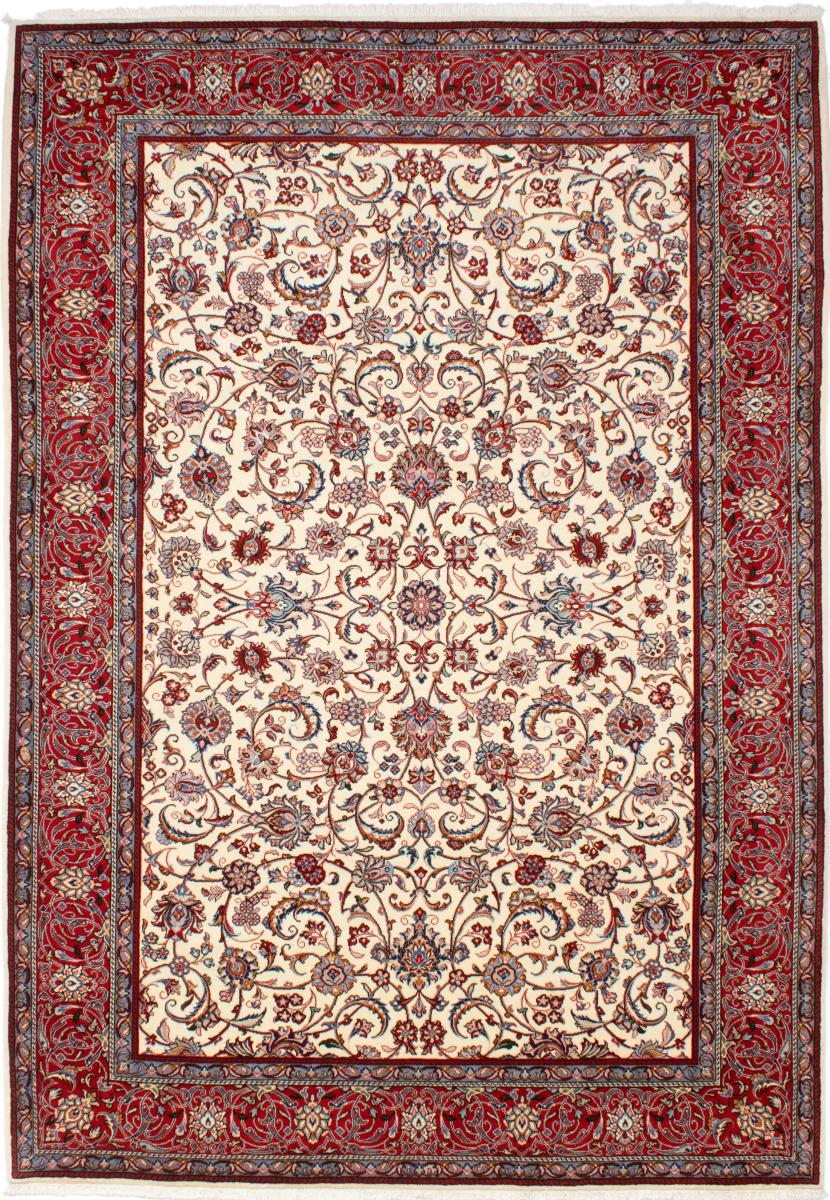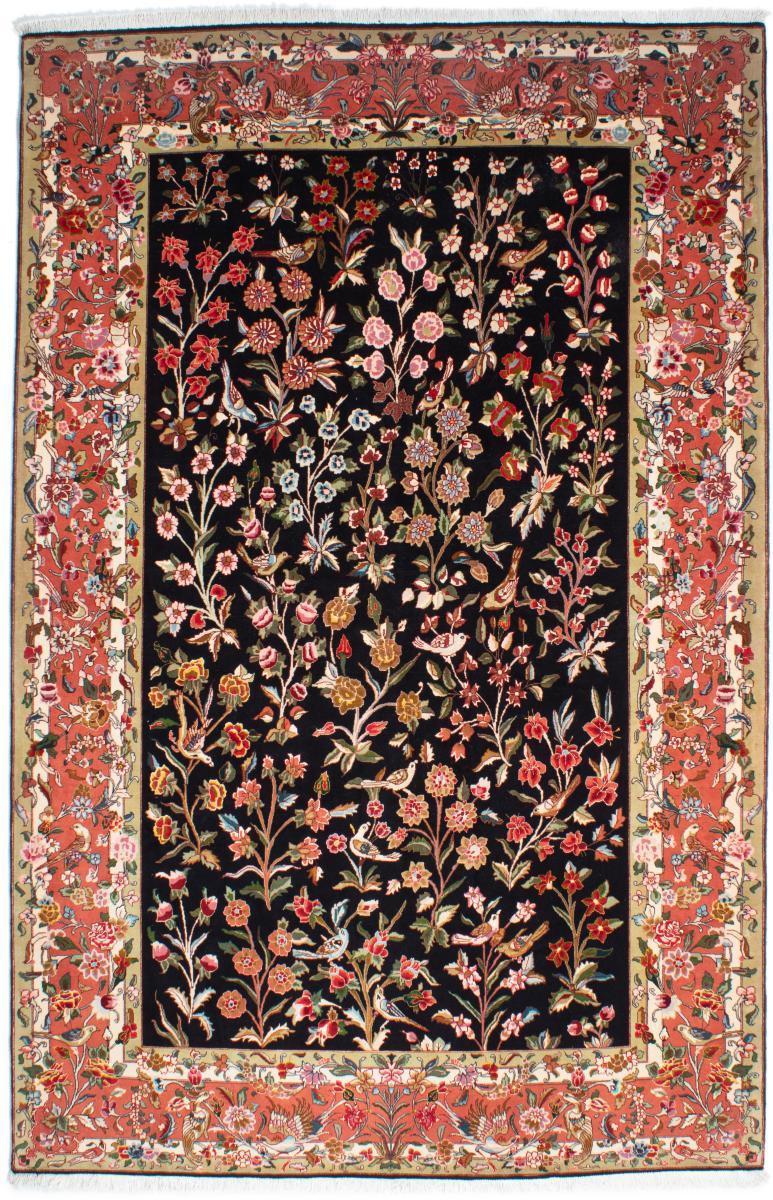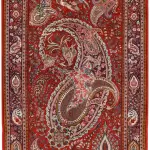"Golfarang" design in Iranian handwoven carpet
The flower design, which is known by various names such as: Kobleni flower, rose, cabbage rose, and jersey flower, entered Iran's arts and crafts from the end of the Safavid period, at the same time as the huge wave of European painting, illustration, and nature paintings, and was widely used on handwovens. and found other Iranian arts. Although, before this pattern, native Iranian red flower was used in the Safavid period fabrics; But to this extent and this type of naturalistic style, whose direct examples can be seen in the art of the 18th and 19th centuries in the West, was not used.
Background of Golfarang design texture in Iran
Due to its beauty, real or abstract and imaginary, flowers have been considered among the most common motifs of Iranian carpets from the distant past to the present day. In fact, the use of flower motifs on handwoven carpets or other handicraft products is a tool for Iranian artists to depict the beauty of nature. The Qajar era is actually the starting point of modernism and westernization in Iranian art due to the acquaintance of Iranians with European art and culture. The art of the Qajar period, especially in the field of carpet design, changed its direction from Eastern to Western content and form. Carpets with a garden pattern, which had a heavenly and spiritual effect during the Safavid era, changed shape and became gardens with earthy and concrete flowers in a European style. Among the Farang-e-Farangs and Farang-Bazahs, the Iranian "Mohammadi Flower" design was imprinted as a beautiful image on the hand-woven carpet and became known as "Frang Flower", and the texture of carpets with the Golfarang design became very popular from the Qajar period onwards.
Calf in Iranian and non-Iranian carpets
The role of roses in carpets is based on European naturalistic designs, in such a way that usually a large and leafy red flower is repeated throughout the text. Also, the Rose Cabbage design has been used in souvenir carpets in the middle of the 19th century AD, Turkish carpets designed in the "Mejidian" style and 19th century carpets of Karabagh and Azerbaijan. In Iranian carpets, the flowers are often deformed from their natural type, and the natural shape of the flower is rarely observed in this handwoven. Changing the role of the materials from their natural state to coordinate with other carpet patterns is a sign of the artistry of Iranian designers and weavers, and this artistic work has such an impact on the pattern of the carpet that it also expresses the "weaving place" of the carpet.
Characteristics of Iranian Golfarang carpet
The natural or modified form of most flowers are used in the design of the Iranian marigold carpet, some of which are: daisies and their varieties, sunflowers, paper flowers, Shah Abbasi flowers, petunia flowers, henna flowers, marshmallow flowers, Syrian flowers, Laleh Abbasi In fact, the flower design is the European rose that has found its way into Iranian carpets. To be more precise, the flower design is inspired by French flowers. This pattern, which is also known as Louis Philippe, was first commissioned by French carpet lovers in the early 13th century. It was woven. The weaving of carpets with this pattern has been continued in Iran for more than a century and is still used in many areas of Iran. One of the distinctive features of Golfarang carpets is the use of pink, indigo, pale green, beige and other unusual colors that are not usually used in the coloring of authentic Iranian carpets.
In which regions of Iran is the Golfarang pattern woven?
In Iran, carpets with naturalistic designs are often woven in the cities of Kerman, Tabriz, Kashan and Isfahan more than in other regions, and in general, it can be said that painting on carpets started mainly in the cities of Kerman and Kashan. But currently, the two cities of Tabriz and Isfahan are also dealing with the texture of pictorial and naturalistic designs. Also, the city of Tabriz has surpassed other places in the inspiration of Western images and elements in the design of European-style woven carpets. To put it more fully, the naturalistic role of gilfarang, which has become common in Iran since the Qajar period, and the weaving of carpets with this design began in the Kurdistan region and has spread in Kerman and some other places as well, sometimes as a spread and sometimes in integrated designs. is used Today, Golfarang design is woven in most of Iran's carpet-weaving areas; But among the most significant of these regions, we can mention Tabriz, Qom, Kashan, Bijar, Sanandaj, Malayer, Havand Arak, Kashmar, Kerman, the carpet weaving areas of Chaharmahal Bakhtiari province, Eilat Khamsa and Arab. In the following, we will discuss the most important regions of Golfarang carpet weaving in Iran and the most prominent characteristics of Golfarang carpets in each of these regions.
Flower design in Tabriz carpet
Carpet manufacturers in Tabriz have been using the Golfarang design along with other popular designs in the region for the past seventy years. Around 1930 AD, the patterns of flowers, which include roses along with other flowers in a naturalistic form, appeared in Tabriz carpets. The role of landscape or pictorial designs of famous and important people and buildings were among other favorite and common designs in this era. The arrival of Golfarang designs under the banner of modernist designs and the use of various colors of pink, yellow, orange, purple with high intensity and blues that are different from the beautiful blue of the old Azerbaijan carpet are among the most obvious features of Tabriz Golfarang carpets.
Flower design in Qom carpet
Since the style and quality of carpet weaving in Qom is very close to Kashan, there is a possibility that the art of carpet weaving entered this region from Kashan. Qom, Yazd, and Nayin did not have significant productions in carpet weaving until the mid-1930s, and so far no carpets dating back to 1940 and woven in Qom have been identified. Around seventy-five years ago, Kashan merchants brought carpet weavers to Qom and carpet weaving began on a limited scale, and after twenty years, carpet weaving continued in an advanced form. The weavers of Qom prefer to weave designs from other regions that have been accepted, with a few changes, and among them, one of the most used designs is the design of Golfarang and Zal al-Sultan. The floral designs of this area have numerous floral bands and the borders are executed with smaller bouquets that are placed on the bands or placed freely. The beautiful and old designs of Qom are very similar to the Indo-Mongolian designs of the 17th and 18th centuries. In recent years, Qom silk flower carpets have gained a lot of fame in terms of beauty, variety of colors and elegance.
Flower design in Kerman carpet
The period between 1300 and 1320 was the peak of the use of flower designs and other non-Iranian elements in urban woven carpets of Iran, especially in Kerman. Between the mentioned years, many orders from European countries, especially France and England, for carpets with non-Iranian floral designs similar to hollyhocks, which at that time were also famous for tapestry designs, caused a large number of Iranian designers, especially in Kerman, to design carpets with Pay these motifs. In the carpet weaving industry of Kerman, Abdul Hossein Mirza Farmanfarma was the first person who created the role of gilfarang and face making among the traditional designs of Iran in the 19th century. Showing the nobility of France with special clothes in the garden and greenery in the French pictorial carpets is one of the features of this country's carpet designs. These designs have also made an impact on some of the well-woven carpets of Kerman at the beginning of the contemporary century. Of course, since the 17th century, a number of woven Iranian carpets, which are patterned with flowers and leafy bushes, are also attributed to Kerman. Also, in Sirjan, which is one of the most important carpet-weaving centers of the Afshars in Kerman, they use designs of flowers, vases, and flowers, which the Afshars call "musi-khani", in the weaving of their carpets. Although the use of roses in the carpet of this region may be late and the beginning of its productivity is in the middle of the 19th century or a little before; But before that, it was used in shawl weaving in much smaller dimensions. After the end of World War II, a new era of American taste began. The American market wanted flower patterns in the style of French woven flowers, as a result, the Kerman designers adapted the woven flower patterns of "Abusan" and "Saunri" and these patterns became known as Gobelin or Golfarang in Iran. For this reason, this period is called the "French" period or the "Gobelins" period. Using two colors, pink and light blue, and placing it among the darker colors, is one of the characteristics of the Asfondeh carpet. The red flower is one of the favorite themes of Esfangah merchants. In the last century, this role was the ideal of Khatloui weavers, and it has been transferred to Esfandah since the beginning of this century. The reasons for this transition are not clear, but the demand for Asfondeh carpets, which has increased since the beginning of this century, can be the reason for these movements. Tanavoli also writes about the old carpet weaving in this region: The ones I have examined all have symmetrical knots and their designs are more like golfarang type with happy and intense colors, although their texture is not as stiff as today's azandehs. The design of Esfandagheh rosette in carpets is generally not different from each other, and it is a pattern of rosette that is repeated in the text of the carpet. In terms of the foundation, it is similar to the famous Musa Khani design, with the difference that Musa Khani's design is geometric, but this design is curved and its flowers are natural. Bardsir is right in the middle of Sirjan Kerman road and as a bridge it has been effective in connecting Kerman carpets and Sirjan nomads. The carpets of this area show a garden of red flowers.

Flower design in Sarouk and Arak carpets
The beginning of the expansion of Arak carpet trade and the increase of foreign trade houses is at the end of the reign of Naser al-Din Shah, the era of Muzaffar al-Din Shah, Ahmad Shah and the beginning of the Pahlavi period. Due to the influence of culture and the application of taste through carpet producers, the region is gradually influenced by European designs and patterns. Even though there are many evidences from this time that the mentioned companies prepared designs and colors themselves and sometimes even provided painted samples of the design to the designers, but the native and local characteristics and the use of special designs and coloring The area also has value and is used. Some of the designs, such as the flower vase and the simple floor, which are influenced by the tapestry designs, by skilled designers and weavers, fit almost as well in Arak as in other regions. In some parts of Arak, such as Sarouk and Farahan, this art dates back to many years ago. In the areas where carpet weaving has a long history, in addition to using the designs used in Qom and Arak and various types of Lakhtranj Shah Abbasi, Khashti Bakhtiari, flower bouquet and tree designs, they also use gerafrang designs in carpet weaving.
Flower design in Lilian's carpet
Lilian, which is located 15 kilometers west, south of the Khomein-Arak road, was the most famous pure Armenian village of Kamreh region, which Armenians called Lilihan. One of the designs used in carpet weaving in this region is the rose design. In this design, there is a large eight-petaled flower in the center of the carpet, which is surrounded by eight roses with their leaves. In Mazalghan, a completely different design is woven into the carpets. With the quality that the elastics of the design are separated from the red text and the plain floor with curved strips. Bouquets of red flowers are placed inside the laches and the middle bergamot.
Flower design in cashmere carpet
Since 1366, due to the excellent and exceptional market of Nain carpets, a huge number of Kashmiri weavers started to supply carpets with this method. Currently, the designs and motifs used in Kashmir, in addition to the designs of Nain, Kashan and image designs and all kinds of underground designs, human, Shah Abbasi Lakh Taranj in the Mashhad style, new Golfarang designs are also woven in this city. Golfarang pattern with special coloring of Kashmiri carpets has been noticed by Kashmiri weavers and designers since late, and its supply and production continues sporadically, and its beginning and expansion cannot be attributed to a specific period. Also, around 32 years ago, clay motifs in the style of Bakhtiari carpets were sporadically seen in Kashmir carpets, and its production was stopped.
Flower design in Birjand carpet
Golfarang design is also woven in the carpets of Birjand region, especially Derakhsh village. Of course, according to Jule, the old sample is not available. Regarding the arrival of this design in Birjand, Mohammad Zahraei (one of the shareholders of Sharq Birjand Company) says: "For the first time in 1310, a cloth patterned with a flower design was given to Shaukat al-Maluk by the order of Reza Shah to weave a carpet according to it. He brought the plan to me. After some time, I drew the plan and presented it. This design has long been imitated in different ways in the carpets of this region. »
Flower design in Isfahan carpet
During the reign of Shah Abbas II Safavid in Isfahan, we witness the movement of illustration and the entry of non-Iranian images into Iranian painting and other traditional Iranian arts such as traditional design and carpet patterns, and the seeds of adapted motifs in the true sense of the word in Iranian textiles, especially Iranian carpets, in this period. Appears. Carpet researcher Toraj Johleh believes that "the transformation of the beautiful Iranian rose into foreign roses and the more unfortunate ones, the transformation of both into today's samples had a deep impact on the Iranian carpet and set it on the path that we are witnessing today. Although the gilfarang style and illustration are scattered and scattered (but measured) in Isfahan carpet, but such a trend has not been able to overshadow its structure and foundation like other carpets. In fact, the approach of the Safavid kings to painting and European methods did not leave an impression on Isfahan carpets, and the city itself, which became a gate for the entry of western works and methods, preserved its carpet with the solid and authentic foundations of Iranian carpets. Most of the patterns of Isfahan's new carpets are made up of lakh and tanraj designs. Flower design along with hunting tree designs and frames, vases, and afshan are among the other designs used in this area.
Flower design in Kashan carpet
In Kashan, the types of Afshan, Guldani, Shekargahi and Gelfarang designs are an important part of the motifs of this region. One of its appearance characteristics is that there are usually two dominant colors in the carpets of this region, which are blue and red, and mixed materials of red and brick; This causes relatively dark uniformity in the color of Kashan Golfarang carpets.
Final word
Golfarang is a motif that appeared in Iranian hand-woven carpets from the Qajar period onwards, and its basis is an adaptation of the French rose in a naturalistic way. The weaving of Golfarang carpets first started in Kurdistan and then reached areas such as Kerman, Tabriz, Isfahan, Kashan, Qom, etc. are the ones that attract many customers in the domestic and foreign markets of Iran's handwoven carpets.
You can inquire about Buying Handwoven Carpets , Buying Handwoven Kilim and Mats , and Buying Handwoven Pictorial Rug Tableaus online from the Hoveida Carpet Store and register all your orders and Wherever you are in the world, deliver it to the desired address in less than 4 working days.
If you are interested in reading other articles in the field of Handwoven carpets or Handwoven Pictorial Rug Tableaus , please refer to Hoveida Carpet Commercial .
Leave a comment
Your email address will not be published. Required fields are marked *












